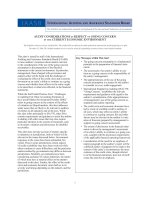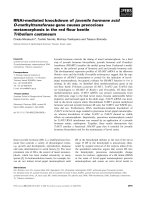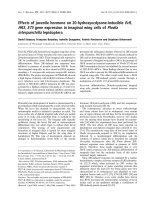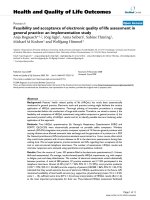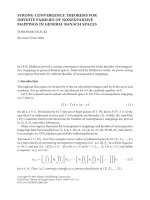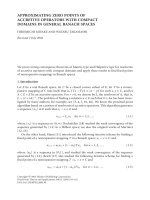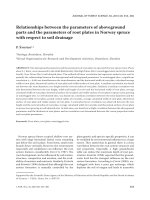topic full respect of juvenile privacy in general comment no 24 2019
Bạn đang xem bản rút gọn của tài liệu. Xem và tải ngay bản đầy đủ của tài liệu tại đây (2.56 MB, 33 trang )
<span class="text_page_counter">Trang 1</span><div class="page_container" data-page="1">
<b>MINISTRY OF EDUCATION AND TRAINING HO CHI MINH CITY OF UNIVERSITY OF LAW </b>
<b>HIGH QUALITY TRAINING PROGRAM </b>
<b>Subject: JUVENILE CRIMINAL JUSTICE </b>
<b>TOPIC: FULL RESPECT OF JUVENILE PRIVACY IN GENERAL COMMENT NO. 24 (2019) </b>
Group 3 CLCQTL43A –
<b>Lecturers: Dr. Le Huynh Tan Duy </b>
<b>Faculty of Criminal Law, Ho Chi Minh City University of Law </b>
Ho Chi Minh City, October 17<small>th </small><b>2022 </b>
</div><span class="text_page_counter">Trang 2</span><div class="page_container" data-page="2">2
<b>LIST OF ABBREVIATION </b>
1 The United Nations Convention on the Rights of the Child CRC
</div><span class="text_page_counter">Trang 3</span><div class="page_container" data-page="3"><b>2.1.T<small>HE PROVISIONS OF THE IETNAMESE JUVENILE CRIMINAL JUSTICE</small>V ... 16 </b>
2.1.1. The privacy of juveniles according to the Vietnam Legal System (Related to Para 66) ... 16
2.1.2. Children's privacy rights in proceedings (Related to Para 67, 68, 69 GC No.24) ... 18
2.1.3. Disclosure of information on juvenile offenders ... 20
2.1.4. Expungement of juvenile offender's conviction ... 21
<b>2.2.C<small>ONTRIBUTIONS TO THE DEVELOPMENT OF </small>V<small>IETNAMESE AW RELATED TO </small>L<small>JUVENILE PRIVACY</small> ... 22 </b>
2.2.1. About the public trial of juvenile cases ... 22
2.2.2. About lifelong protection principles ... 23
2.2.3. About protecting the child9s identity from the media ... 24
<b>III. SOME PROVISIONS OF OTHER COUNTRIES ABOUT THE JUVENILE’S PRIVACY ... 25 </b>
<b>3.1.S<small>OME PROVISIONS IN ICTORIAN LAW</small>V ... 25 </b>
3.1.1. The children9s privacy during proceeding ... 25
3.1.2. The child justice hearing ... 26
3.1.3. Information publication ... 26
<b>3.2.T<small>HE PROVISIONS OF JUVENILE PRIVACY OF OTHER COUNTRIES</small> ... 27 </b>
<b>IV. CONCLUSION ... 29 </b>
<b>REFERENCES ... 30 </b>
</div><span class="text_page_counter">Trang 4</span><div class="page_container" data-page="4">4
<b>INTRODUCTION </b>
The privacy of juveniles in juvenile criminal justice is certainly an essential matter. As juveniles are considered to be more vulnerable to attack and interference, both physical and psychological, their privacy should be kept confidential to avoid such interference and attack.
Nations have introduced legal basis for the above matter via international regulations such as the CRC, General Comment No. 24…. Vietnam has also adopted some of the regulations into its domestic law. However, there's still much to do as there are still some unspecific regulations in our law system on juvenile privacy. We need to display our commitment on juvenile privacy in juvenile criminal justice in our domestic law more clearly to ensure the best benefit and for the education of the juveniles who regrettably committed a crime.
<b>Too long to read onyour phone? Save</b>
to read later on your computer
Save to a Studylist
</div><span class="text_page_counter">Trang 5</span><div class="page_container" data-page="5">5
<b>I. ANALYSIS OF PARA 66 -71 OF THE GC24 1.1. Definition of privacy </b>
Privacy is an oft-used but ill-defined term that has been the subject of significant commentary over an extended period. Although concern was expressed during drafting as to the confusion surrounding its meaning, we were not prepared to offer any clarification about its scope. The jurisprudence of international human rights bodies reveals that the right to privacy has at least a few discrete dimensions which relate to the autonomy and normative agency of individuals (including children). <small>1</small>
These dimensions are: physical and psychological integrity; decisional autonomy; personal identity; informational privacy; and physical/spatial privacy. <small>2</small> Critically, it highlights the additional issues that arise as a result of parents' and/or the state's ability to restrict children's right to privacy for valid protection grounds.
<b>1.2. Information that could reveal a child’s identity </b>
In the General Comment No.24 (GC24), privacy of a child in juvenile justice is regulated in Article 66-71 as follow:
Para 66 of GC24. The right of a child to have his or her privacy fully respected during all stages of the proceedings, set out in article 40 (2) (b) (vii), should be read with articles 16 and 40 (1).
Since there is a risk of children and their families being attacked due to hate, children's privacy in juvenile justice must be ensured to protect their legitimate rights.
Where a child is accused or is counted as having violated criminal law, their privacy must still be fully respected during all stages of proceedings. Every child has the right to privacy. The law must protect his/her privacy, family, home, communications and reputation (or good name) from any attack. Moreover, States Parties recognize the right of every child alleged as, accused of, or recognized as having infringed the penal law to be treated in a manner consistent with the promotion of the child's sense of dignity and worth, which reinforces the child's respect for the human rights and fundamental freedoms of others and which takes into account the child's age
<small>1 John Tobin, Sarah M Field, The UN Convention on the Rights of the Child: A Commentary (Art.16 The Right to Protection of Privacy, Family, Home, Correspondence, Honour, and Reputation) Oxford Commentaries on ,International Law (28 March 2019). </small>
<small>2 Id. </small>
</div><span class="text_page_counter">Trang 6</span><div class="page_container" data-page="6">6
and the desirability of promoting the child's reintegration and the child's assuming a constructive role in society. This provision requires that States must at least ensure that children have their privacy fully respected at all stages of the proceedings.
The United Nations Convention on the Rights of the Child (CRC) Article 16
<1. No child shall be subjected to arbitrary or unlawful interference with his or her privacy, family, home, or correspondence, nor to unlawful attacks on his or her honor and reputation.
2. The child has the right to the protection of the law against such interference or attacks.=
Article 16 lists six specific interests which are to be protected against unlawful interference or attack - privacy, family, home, correspondence, honor, and reputation. The right to privacy has at least 05 discrete dimensions which relate to the autonomy and normative agency of individuals (including children). These dimensions are: physical and psychological integrity; decisional autonomy; personal identity; informational privacy; and physical/spatial privacy.
(i) Physical and Psychological Integrity
Violations of a child9s bodily integrity that reach the threshold of torture or cruel inhuman degrading treatment will never be justifiable, given the absolute prohibition on such treatment. Thus, a violation of this prohibition will always constitute a violation of a child9s right to privacy. However, the right to privacy has a residual application in those cases where there is an interference with a child9s physical and/or psychological integrity that does not reach the threshold for torture or cruel, inhuman, and degrading treatment.<small>3</small>
From a practical perspective, the extension of a child9s right to privacy to include a child9s physical and psychological integrity means that this right will be engaged in a range of practices beyond corporal punishment including, for example, medical experimentation without consent, non-consensual drug testing, body searches (both
<small>3Costello Roberts v UK (1993) (concerning corporal punishment of a child, holding that there may be circumstances in which the protection of art 8 might extend beyond the protection afforded by the prohibition of torture), paras 34-36; Raninen v Finland (1997) 26 EHRR, page 563 para 63. </small>
</div><span class="text_page_counter">Trang 7</span><div class="page_container" data-page="7">7
internal and external), and even the use of handcuffs, which interfere with a child9s physical integrity. <small>4</small>
(ii) Decisional autonomy
The right to privacy includes the capacity to make decisions regarding how an individual leads his or her private life. Indeed, the European Court has held that the right to privacy 8is primarily intended to ensure the development of ... the personality of each individual and 8that the notion of personal autonomy is an important principle underlying its interpretation9.<small>5</small>
The protective capacity of parents, and indeed the state, cannot justify the intervention or restriction on a child9s bodily autonomy when a child has reached a level of maturity whereby he or she properly understands the consequences of seeking a health intervention (such as access to contraception or abortion) or refusing assistance (such as a refusal to accept lifesaving medical treatment). This is because when a child9s maturity and understanding reach a level that would be equivalent to that expected of an adult with respect to the same procedure, there can be no legal or moral justification for adopting a paternalistic approach with respect to the treatment of that child9s views which must be treated as being determinative of his or her best interests in such circumstances.
(iii) Personal identity
The right to privacy entitles adolescents to have access to their records held by educational, health care, childcare and protection services, and justice systems. This approach is consistent with case law from ECtHR which suggests that the right to privacy also embraces 8aspects of an individual9s physical and social identity9.<small>6</small>
A child9s identity includes the right to a name, a nationality, to be registered immediately after birth, as well as elements of a child9s religious and cultural identity.<small>7</small>
(iv) Informational privacy
<small>4 John Tobin, 8Time to Remove the Shackles: Te Legality of Restraints on Children Deprived of Their Liberty under International Law9 (2001), International Journal of Children9s rights, page 213. </small>
<small>5Botta v Italy (1998), 26 EHRR 97, para 32; Von Hannover v Germany (2005) 40 EHRR 1, para 95., Pretty v United Kingdom (2002) 35 EHRR 1, para 61. </small>
<small>6 CRC Committee, 8General Comment No 20 on the implementation of the rights of the child during adolescence9 (6 December 2016) CRC/C/GC/20 para 46. </small>
<small>7 CRC art 7 and 8; ICCPR Articles 24 (2) and (3); ACRWC art 6; ACHR Articles 3, 18, and 20. </small>
</div><span class="text_page_counter">Trang 8</span><div class="page_container" data-page="8">8
For the protection of information created by a child, information that is created by a person for personal use cannot be accessed or disseminated without the consent of that person unless such access and dissemination is lawful and non-arbitrary.
For the protection of information about a child, it contains the information which is created by the various individuals and agencies, whether state or non-state, that gather, collect, hold, and have the capacity to disseminate information about children whether it be schools, medical professionals, police agencies, courts, social workers, banks, sporting clubs, and increasingly, telecommunications companies and social media providers.<small>8</small>
(v) Physical/spatial privacy
This refers to the capacity of a child to enjoy a physical space to the exclusion of others. The significance of this entitlement is illustrated within the context of a child who is deprived of his or her liberty.
There is a tendency within the literature to subsume each of these interests under the rubric of privacy. Arguably, this is justified given the expansion in the meaning of privacy. At the same time caution should be exercised to ensure that there is an understanding as to the parameters of each discrete term. Moreover, there is merit in recognizing that honor and reputation are concepts that are concerned with the public standing of a child as opposed to the more intimate and private nature of concepts such as privacy, family, home, and correspondence.
Article 40 of CRC
“1. States Parties recognize the right of every child alleged as, accused of, or recognized as having infringed the penal law to be treated in a manner consistent with the promotion of the child9s sense of dignity and worth, which reinforces the child9s respect for the human rights and fundamental freedoms of others and which takes into account the child9s age and the desirability of promoting the child9s reintegration and the child9s assuming a constructive role in society.
2. To this end, and having regard to the relevant provisions of international instruments, States Parties shall, in particular, ensure that:
(b) Every child alleged as or accused of having infringed the penal law has at least the following guarantees:
<small>8 The Commentary, page 569. </small>
</div><span class="text_page_counter">Trang 9</span><div class="page_container" data-page="9">9
(vii) To have his or her privacy fully respected at all stages of the proceedings.= Article 40 (1) of CRC
The overriding right of the child to maintain regular personal relations and direct contact with his or her parents enshrined in Article 9(3) of the Convention, is one aspect of helping a child achieve this sense of well-being. The Beijing Rules specifically highlight the importance of maintaining the relationship with the child9s family, so that the child is not treated in isolation from the family. <small>9</small>
One of the conclusions from the Day of Discussion was that, 8the child9s socialization should be promoted through increasing the involvement of families in children9s programs and through facilitating the release of children for home visits.9<small>10</small>
Another fact of promoting the child9s sense of well-being is that in all cases where children are 8alleged as, accused of, or recognized as having infringed the penal law9, they should, according to the CRC, be treated in a manner consistent with the promotion of their sense of dignity and worth, and which reinforces their respect for human rights. Any treatment should take into account the child9s age and the desirability of promoting their 8reintegration9 and their assumption of 8a constructive role in society.9
Article 40 (2)(b)(vii) of CRC
Article 40 (2)(b)(vii) of the CRC places a duty on States Parties to guarantee to children their right to privacy at all stages of the proceedings. One aspect of this right is highlighted by the CCPR, which allows for the public to be excluded from juvenile justice proceedings and for the judgment not to be made public. Such proceedings include matrimonial disputes concerning the guardianship of children. Decisions that have profound consequences for the lives of children and their families ought to be open to public scrutiny. This is a forceful argument that child advocates have to confront. <small>11</small> Any exception to the principle of open justice can only be sustained by reliance upon the best interests of the child. With open proceedings, the chances of the child being stigmatized would increase and the informality would decrease. However, there is a
<small> Van, Bueren, Geraldine. A Commentary on the United Nations Convention on the Rights of the Child, Article 40: Child Criminal Justice : Child Criminal Justice, BRILL, 2005. ProQuest Ebook Central, </small>
<small> 10</small>
<small> CRC Committee, Day of General Discussion: The administration of juvenile justice (UN Doc. CRC/C/43 Annex VIII, 1995)(hereinafter: CRC Committee, Day of General Discussion ), para. 230. </small>
<small> C. van Nijnatten, 8Behind Closed Door: Juvenile Hearings in the Netherlands9, International Journal of Law and the Family 3, 1989, page 177. </small>
</div><span class="text_page_counter">Trang 10</span><div class="page_container" data-page="10">10
danger that in human rights cases, violations may go unnoticed in proceedings not open to the public.
Another fact of the right to privacy is highlighted by the Beijing Rules, which recommends in principle that information leading to the identification of a juvenile offender should not be published. Such information would include but is not limited <small>12</small> to, the name. This protects the child9s right to privacy and serves to prevent children from being identified or labeled as delinquents as criminological research has shown such labeling has had detrimental effects on children. The CRC clearly provides that the child9s right to privacy should be 8fully respected9 at all stages in the proceedings and it is arguably implicit in the right to privacy that a child should not be identified. In V v UK, the applicant complained that the public nature of criminal proceedings against a twelve-year-old that took place over three weeks in public in an adult Crown Court violated his rights under Article 3 of the European Convention. The European Court recognized that one of the minimum guarantees provided by Article 40(2)(b) of the CRC is that children accused of crimes should have their privacy respected at all stages of the proceedings.<small>13</small>
<b>Para 67 of GC No.24 regulated that <States parties should respect the rule that </b>
child justice hearings are to be conducted behind closed doors. Exceptions should be very limited and clearly stated in the law. If the verdict and/or sentence is pronounced in public at a court session, the identity of the child should not be revealed. Furthermore, the right to privacy also means that the court files and records of children9s should be kept strictly confidential and closed to third parties except for those directly involved in the investigation and adjudication of, and the ruling on, the case. =
The General Comment No.24 requires members to respect the right to privacy of children in child justice hearings, stated that such hearings should be conducted behind closed doors, meaning not for public attendants. However, the convention does allow states parties to regulate limited exceptions where child justice hearings don9t need to be conducted behind closed door clearly in their laws. This means that states can only conduct child justice hearings publicly when they already have regulated such hearings
<small> Beijing Rule 8(2). 13</small>
<small> Van, Bueren, Geraldine. A Commentary on the United Nations Convention on the Rights of the Child, Article 40: Child Criminal Justice : Child Criminal Justice, BRILL, 2005. ProQuest Ebook Central, </small>
<small> </small>
</div><span class="text_page_counter">Trang 11</span><div class="page_container" data-page="11">11
as limited and clear exceptions in their law as the convention requires them to be conducted behind closed doors. Whether verdicts and/or sentences are pronounced publicly at a court session, information that could reveal the identity of a child shouldn9t be revealed.
The right to privacy also includes that court files and records of children should be kept strictly confidential and closed to any third parties except, where needed, for those directly involved in the investigation and adjudication of, and ruling on, the case.
The right to privacy of child offenders may be said to have ramifications that extend beyond their childhood. In Venables v News Group Newspapers, the boys who killed James Bulger were granted lifelong anonymity. This decision reflected their status as children when they were sentenced, although the decision was primarily concerned with the extent of the threat to their lives if their identities were ever revealed. <small>14</small>
The importance of the Beijing Rules has been acknowledged in the UN resolutions on the administration of child criminal justice and by the CRC Committee when commenting on the reports of State Parties. It may well be that the Beijing Rules have their most decisive impact when considered along with other international standards in criminal policy discussions and in legislation. <small>15</small>
The duty of States Parties also extends to the privacy of records. The details are usefully set out in the non-binding Beijing Rules but, in substance, they form a part of the child9s right to privacy, which is found in binding treaty form. States Parties are under a duty to keep records of juvenile offenders 8strictly confidential9 and inaccessible to third parties. Access to such records should be limited to those individuals who are directly concerned with the case. Finally, Beijing Rule 21(2) also provides that where a juvenile is subsequently involved in adult proceedings, the records of any juvenile proceedings should be inadmissible. <small>16</small>
<small> High Court of England and Wales, Venables v News Group Newspapers (8 January 2001). See also Mary Bell9s case in which continued anonymity was also granted in order to pro- tect the right to private and family life which she shared with her daughter. </small>
<small> O. Bonke, The Application of the United Nations Standards and Norms in Crime Prevention and Criminal Justice: Expert Group Meeting, Austria 10-12 February 2003 (Vienna, UN Office on Drugs and Crime, 2003), page 49. </small>
<small> Van, Bueren, Geraldine. A Commentary on the United Nations Convention on the Rights of the Child, Article 40: Child Criminal Justice : Child Criminal Justice, BRILL, 2005. ProQuest Ebook Central, </small>
<small> </small>
</div><span class="text_page_counter">Trang 12</span><div class="page_container" data-page="12">12
<b>Para 68 of GC No.24 regulated that <Case-law reports relating to children </b>
should be anonymous, and such reports placed online should adhere to this rule. = Case-law reports relating to children should their anonymity be maintained, including those that are placed online.
In personal injury proceedings involving a child, it was appropriate to grant an anonymity order prohibiting her identification since it would defeat the purpose of the proceedings to ensure that they received and kept compensation awarded for her injuries. Publication of their name was not in the public interest, and the curtailment of them and their family9s right to respect their private and family life that would occur could not be justified.<small>17</small>
For juveniles who commit crimes, publishing their names in the press does not mean anything and can only expose the child to later torment and social estrangement from them. This provision makes it easy for the child to rebuild his or her life and have a full mental development after the sentence is completed.
This is a very progressive regulation. Currently, in almost every country, the Internet is almost everywhere. Therefore, protecting children's privacy also needs to be protected on the Internet. In many States, Case-law reports must be published on the official web of the court and because the speed of spreading on the internet is extremely strong and fast, keeping the privacy of children on the digital network is extremely important and necessary.
<b>Para 69 of GC No.24 regulated that <The Committee recommends that States </b>
refrain from listing the details of any child, or person who was a child at the time of the commission of the offense, in any public register of offenders. The inclusion of such details in other registers that are not public but impede access to opportunities for reintegration should be avoided. =
Art 16, Convention on the Rights of the Child: <No child shall be subjected to arbitrary or unlawful interference with his or her privacy, family, home or correspondence, nor to unlawful attacks on his or her honor and reputation.=
Because the defendant is a child, his or her future progress may well be assisted by restricting publication. The publication could well have a significant effect on the
<small> Rosalind English, How to keep children anonymous in personal injury cases (28 November 2012), [ accessed 16/10/2022 </small>
</div><span class="text_page_counter">Trang 13</span><div class="page_container" data-page="13">13
prospects and opportunities of the young person, and, therefore, on the likelihood of effective integration into society. Due to their 8physical and mental immaturity9, juveniles charged with criminal offenses cannot be held as responsible as adults for their actions and require special safeguards in their interactions with criminal justice systems.<small>18</small> The public register of offenders is a procedure that should be eliminated in order to help them.
This is a progressive regulation that protects the development of juveniles when they have made mistakes before they were fully aware. This approach encourages children to accept responsibility for their actions, and to offer rehabilitation services that help children who break the law to reintegrate and become productive citizens in society.
<b>Para 70 of GC24. regulated that <In the Committee9s view, there should be </b>
lifelong protection from publication regarding crimes committed by children. The rationale for the non-publication rule, and for its continuation after the child reaches the age of 18, is that publication causes ongoing stigmatization, which is likely to have a negative impact on access to education, work, housing or safety. This impedes the child9s reintegration and assumption of a constructive role in society. States parties should thus ensure that the general rule is lifelong privacy protection pertaining to all types of media, including social media.=
Persons under the age of 18 in the criminal justice system are at very high risk of being discriminated against and may be negatively affected by stigmas and prejudices in society. This greatly compromises the important goal of juvenile justice to ensure their recovery and reintegration. Identifying a Defendant in the media may constitute an additional and disproportionate punishment on the child or young person. Therefore, international organizations highly require the protection of the privacy of juvenile. Respecting this right to privacy is extremely important for protecting a sense of honor and dignity, and for helping to reduce the risk of injury to juvenile when they are involved in criminal proceedings.
Having a lifetime privacy protection mechanism involving all types of media would be very beneficial for a child, or a person who was a child at the time of the
<small> Protecting the Identity of Juveniles in Criminal Proceedings in Viet Nam and Victoria, Le Huynh Tan Duy and Marilyn McMahon </small>
</div><span class="text_page_counter">Trang 14</span><div class="page_container" data-page="14">14
commission of the offense, having the opportunity to reintegrate. with the community, avoid disagreement, distance.
<b>Para 71 of GC No.24 regulated that <Furthermore, the Committee recommends </b>
that States parties introduce rules permitting the removal of children9s criminal records when they reach the age of 18, automatically or, in exceptional cases, following an independent review.=
Measures and sanctions for children in conflict with the law should always be constructive and individualized responses to the committed acts, bearing in mind the principle of proportionality, the child9s age, physical and mental well-being and development and the circumstances of the case. The right to education, vocational training, employment, rehabilitation and reintegration should be guaranteed.
In order to promote the reintegration within society, and in accordance with the national law, criminal records of children should be non-disclosable outside the justice system on reaching the age of majority. Exceptions for the disclosure of such information can be permitted in cases of serious offenses, among other things for reasons of public safety or when employment with children is concerned. <small>19</small>
Confidentiality and personal data of children who have participated in judicial or other proceedings and other interventions should be protected at all stages and this protection must be guaranteed by law. This means that no personal information or data is publicly available, especially in the mass media, which could lead to disclosure or indirect disclosure…including images of children, the introduction of the child or young family, names and addresses of family members and audio and visual records.<small>20 </small>
This is a progressive regulation, however, which requires careful consideration of the extent of conduct for which juveniles are convicted. If it is a serious behavior, a high level of deterrence is needed. On the contrary, if it is a crime that is not too serious, the Court may consider deleting the criminal record of juveniles to create conditions for the child to develop the best psychologically after completing the sentence.
<small>19 Council of Europe Publishing, "Guidelines of the Committee of Ministers of the Council of Europe on child-friendly justice", page 32, para. 83. </small>
<small>20 Vietnam's Ministry of Justice, <Child-friendly legal aid in the criminal justice system and the compatibility of Vietnamese law in child-friendly legal aid=, </small>
<small>[ accessed 16/10/2022 </small>
</div><span class="text_page_counter">Trang 15</span><div class="page_container" data-page="15">15
<b>1.3. Conclusion </b>
A lot has been said about privacy over a long period of time despite the fact that it is a phrase that is often used but poorly defined. The legal precedent set by international human rights organizations demonstrates that the right to privacy includes at least a few distinct aspects that are connected to people's autonomy and normative agency (including children). In the General Comment No.24, privacy of a child in juvenile justice is regulated in Article 66-71, which is interpreted along with Article 16, Article 40(1), Article 40 (2) (b) (vii) and some specific Rules.
</div><span class="text_page_counter">Trang 16</span><div class="page_container" data-page="16">16
<b>II. COMPARE VIETNAMESE LAWS WITH THE UN STANDARDS AND NORMS </b>
<b>2.1. The provisions of the Vietnamese juvenile criminal justice </b>
On February 20th 1990, Viet Nam was the first country in Asia and the second country in the world to ratify The United Nations Convention on the Rights of the Child (UNCRC). And throughout the Vietnamese Constitutions, from the Constitution 1946 to the current Constitution 2013, children's rights are always recognized.
Currently, in the Penal Code and Criminal Procedure Code, there are specific provisions of the law, which aim to ensure the privacy of juvenile offenders. These provisions are about the rights and obligations of minors; obligations of agencies and individuals given authority to institute proceedings, ... for juvenile offenders. All these provisions express the ideas and principles of our State that are humane and aim to ensure that the rights of minors are not unlawfully deprived.
The provision of the Vietnamese juvenile criminal justice has the following significant titles:
<b>2.1.1. The privacy of juveniles according to the Vietnam Legal System (Related to Para 66) </b>
CRC, Art 16 (1) provides: <No child shall be subjected to arbitrary or unlawful interference with his or her privacy, family, home or correspondence, nor to unlawful attacks on his or her honor and reputation.=. In this spirit, Article 21 of Children Law 2016 specially provides the child's privacy: "The child has the inviolable rights to privacy, personal secrets and family secrets in his/her best interests; The child has his/her honor, dignity, reputation, mail, telephone, telegraph secrets and other forms of exchange of private information protected by law; has his/her private information protected against unlawful intervention."; Clause 2, Article 414 of The Criminal Procedure Code, also states that 01 of principles of legal proceedings is: <Personal information of individuals below 18 years of age must be kept confidential.= And Clause 9, Article 9 of The Press Law 2016 also prohibits the posting and distribution of information that "affects the normal physical and mental development of children".
The provision <The child has the right to the protection of the law against such interference or attacks= of CRC, Art 16 (2) is also internalized by Vietnam in Clause 2,
</div>